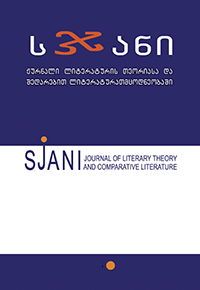ჰერმენევტიკა და მხატვრული ტექსტის ინტერპრეტაცია
Hermeneutics and Interpretation of Fiction
Author(s): Konstantine BregadzeSubject(s): Literary Texts
Published by: ლიტერატურის ინსტიტუტის გამომცემლობა
Keywords: hermeneutics; explaining and understanding text; fiction; manifestation; essence.
Summary/Abstract: In general terms, hermeneutics is the art of explaining and understanding facts endowed with certain concept (Sinngebilden), while in a narrower sense the term refers to the art of explaining and understanding (interpreting) texts (Fr. Schleiermacher). Consequently, explaining and understanding make up one dialectical unity generating the so-called hermeneutic circle, the potential for unrestricted expansion being its intrinsic property: that is, if something is perceived in the consequence of explaining and understanding, the perceived becomes the basis for the further process of explainig and understanding, which goes on continuously until the implicit concept (the inner logos) inherent with the text is ultimately perceived. Interpretation of fiction implies the interaction of essence (Wesen) and manifestation (Erscheinung). That is, the implicit concept inherent with the text is the essence while its outer side, i.e. the literal sense, is the manifestation. Since a text is a priori a linguistic fact, a written expression of verbal activity, the essence of a text, i.e. the implicit concept of a text is rooted in language and is manifested as textualized language (die vertextete Sprache). This brings forth the following problem: how is the essence actualized, manifested in the language of a text – in a complete, absolute way or incompletely? Since due to its non-self-sufficient nature language is not capable of fully rendering the inner logos, beyond the uttered, expressed word (manifestation), i.e. beyond the immediate, literary word there always remains something to be uttered (das Aussagende), i.e. the inner, implicit concept of a text. At this point, the ultimate goal of hermeneutics becomes apparent: to explain and perceive, i.e. understand the implicit concept, the inner logos of a text. On its part, the process of explaining-understanding is based on the method of the hermeneutic circle (Hermeneutischer Zirkel): from the whole to an individual and vise versa, from an individual to the whole. In this case, the whole (das Ganze) is the main, implicit concept (the original concept), while individual (das Einzelne) refers to a string of sub-concepts of a text. Thus, interpretation of fiction is an endless process of interaction of the whole and individual leading to the perception of inner logos of a text.
Journal: სჯანი
- Issue Year: 2009
- Issue No: 10
- Page Range: 38-53
- Page Count: 16
- Language: Georgian

